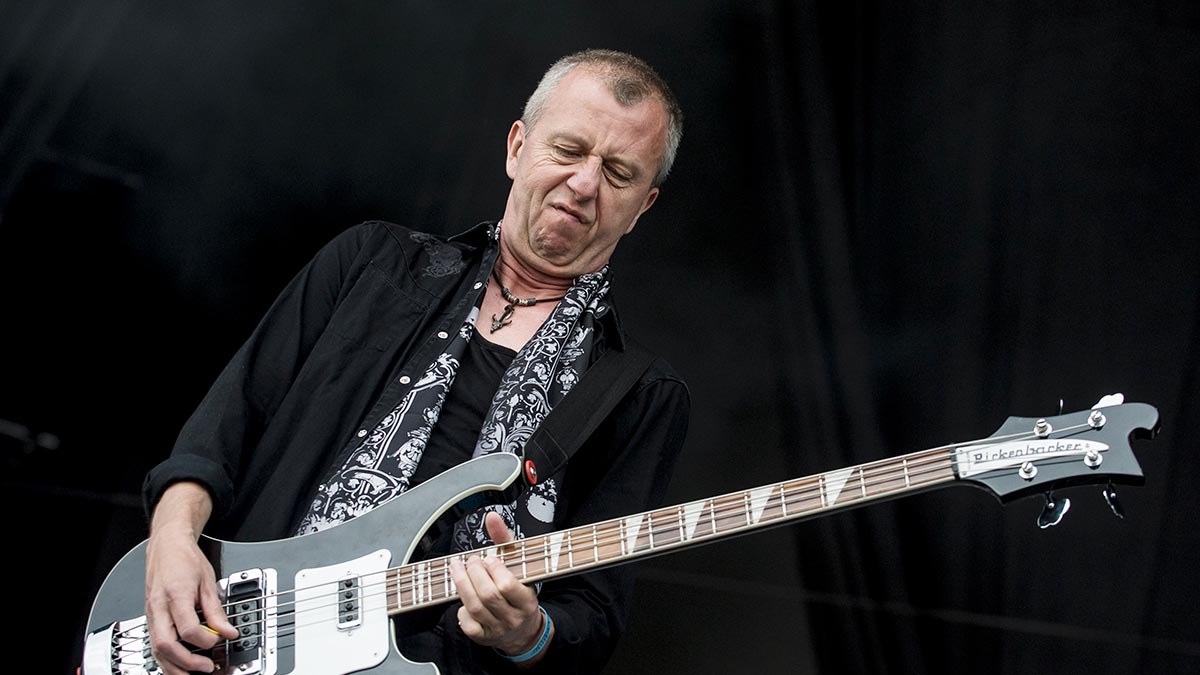Thunder’s Chris Childs on his 5 best bass albums
From his improvisational collaboration with Mick Cox to Thunder’s latest, All the Right Noises, Childs talks through some of the most memorable moments in his discography

Christopher James Childs, to give him his full name, was born in the UK village of Writtle, Essex in 1959. The bass player and producer joined rock legends Thunder in 1996 and continues to hammer out irresistible tunes with the band to this day.
In the live arena, his low-end antics have been much in demand by a diverse host of names including Paul Young, Roger Daltrey, Russ Ballard, Don Airey, Lulu and Samantha Fox.
He has lent his bass skills to other household names, including Bad Company vocalist Robert Hart, Colin Blunstone, Andy Summers, Robert Fripp, Then Jericho, and Go West. He has also guested alongside other bass legends like Nathan
East, Pino Palladino, and Abraham Laboriel.
It’s fair to say that Childs is one of the UK’s most talented and high-achieving bassists, then, but it doesn’t stop there: he’s also very active in the roles of producer, engineer, mastering engineer, and graphic designer.
He’s also a fellow whose enthusiasm for music and bass playing is as honest and thoughtful as it is inspiring. We caught up with Childs recently and he waxed lyrical about his influences, various recording styles, Frankenstein bass guitars, and the fascinating synergy of feel, technique, and aggression.
1. Thunder – All The Right Noises (2021)
“We recorded at Rockfield, largely live, to get the vibe. Luke Morley, our guitarist, is also like the musical director, and he produced it too. When he writes the demos, he writes the basslines, and obviously I get the opportunity to put in anything that might be appropriate – fills and so on.
“He’s actually a very good bass player, with a bassist’s sensibilities, and that means he really approaches the lines from a bass point of view. Now, 99 percent of the time I use a pick, which is more appropriate when you’re going for a more aggressive sound, but on the song Don’t Forget To Live Before You Die, I played fingerstyle with quite a distorted sound.
Get The Pick Newsletter
All the latest guitar news, interviews, lessons, reviews, deals and more, direct to your inbox!
Recording live brings some of that back, and can inspire you: Something can just pop out, like a little spark of imagination
“That was fun to do. When I first started recording, it was on two-inch tape, using 24-track machines, so you didn’t get that many goes at it. You had to get your technique down, and if you wanted to do something different, you had to have the confidence that you were going to get it right.
“Recording live brings some of that back, and can inspire you: Something can just pop out, like a little spark of imagination. Listen out for a slide up the fretboard in Don’t Forget... that isn’t difficult or technically challenging, but it gives extra power and excitement, and was totally unplanned.”
2. Mick Cox – Compose Yerself (1990)
“We went to the studio with no preparation whatsoever. Mick would play a song, we’d learn it and then just as soon as we got on top of it, we’d record it. I’m proud of what I played on this, with lots of fretless bass, which I don’t often get a chance to do.
“It was the first record that I had a hand in producing and mixing, too.
I made the bass myself, actually, and I can’t believe I did that, looking back on it. I didn’t have a great deal of power tools at the time, and so my lounge was completely covered in wood shavings and sawdust.
Mick gave us a lot of freedom, with the chords and the shape of the songs, so we literally came up with the parts on the spot
“Mick gave us a lot of freedom, with the chords and the shape of the songs, so we literally came up with the parts on the spot from front to back. It was a fascinating process, because Mick was a fascinating character.
“He told us that Jimi Hendrix once gave him a multicolored, psychedelic-painted Gibson Flying V which subsequently got stolen, but whoever had it away clearly didn’t realize its provenance and how valuable it would be, because it just disappeared.
“The album is memorable for me because one of the tracks was recorded on the day my daughter Rachel was born. She appeared at about 4am – and about six hours later we were in the studio again. The album is dedicated to her.”
3. Never the Bride – Never the Bride (1995)
“This was the first album I recorded in America. We did two weeks of pre-production in the rehearsal room to get the vibe together, and then went over to Runway Recording in Los Angeles. We recorded it live, which is a brilliant way to work, but I was working with headphones, isolated, with a mixer and monitors so I had my own mix.
“This was a really different approach to making records, because the drummer had a tech who sorted the kit and changed the heads, and it was so different to working in England. It was a great studio and a really good record to make – and it’s all about the time and the place. That’s what stands out for me.
“Studios vary in vibe and gear. These days, I like to use Focusrite preamps and a Universal Audio Apollo Twin straight into them. I also tend to use a lot of Softube software, and there are hardware controllers for that, which is very important. That tactile experience makes your ears take over, rather than simply using your eyes to adjust parameters on a screen.
“If I’m going to do a general session, I take a Fender Bassman and DI with whatever boxes they might have in the studio. I’ve been working on Cubase for a while, but I have ProTools too in case somebody wants to use it.”
4. Andy Summers – XYZ (1987)
“On this album, the part on the song Eyes of a Stranger that I recorded was made up of really fast eighth notes, and Andy said, ‘Play it only with downstrokes!’ I thought, ‘Okay, this is a rite of passage’, so I did it – my hand was like a claw by the end of it.
“At first, I didn’t understand it: I thought he was asking me to do something that wasn’t really necessary, but it turned out to be exactly what he was after – that aggression and consistency in the sound. Andy is a very accomplished guitarist, of course, and though I wouldn’t say that it contains some of the best bass playing I’ve ever done, this record was definitely interesting to make.
John Entwistle had grace and aggression in his playing, and you realize that it’s the intent of that playing, even more than the choice of notes, that makes it incredible
“That’s because technique wasn’t important this time. When most bass players start out, they strive to become as technically adept as possible – but it’s not always about sheer technique.
“Look at John Entwistle, who played very messily, technically speaking, but what he did was absolutely unbelievable – you don’t realize how good he was until you try and recreate his lines. He had grace and aggression in his playing, and you realize that it’s the intent of that playing, even more than the choice of notes, that makes it incredible.”
5. Lonerider – Attitude (2019)
“I’ve been a fan of drummer Simon Kirke forever, because I was a huge fan of Free and Bad Company. They were the influences on my playing as I was learning, as was Andy Fraser, so getting the opportunity to work with Simon in the studio was a dream come true.
“You never know, actually, when you work with someone like that, how they’re going to be, but Simon was absolutely brilliant – the nicest guy, everything that I’d hoped he would be. He was very energetic, and very into the music: We would record as soon as we got an idea down. I was thinking, ‘The guy who played on All Right Now is truly enjoying what I’m playing.’
“We did another session last year, recorded remotely, and you know, it felt as though something had fallen short, because it felt very different. The process of recording online was a lot more clinical than in person, because without the collaboration, you don’t get that spark.
“I guess it’s a product of the times, but I like the finished record, and it was a lot of fun to play with Simon before that. I’ve ended up doing a few records like this over the last couple of years, with people sending me stuff and recording remotely, as pretty much everyone has.”
Bass Player is the world’s most comprehensive, trusted and insightful bass publication for passionate bassists and active musicians of all ages. Whatever your ability, BP has the interviews, reviews and lessons that will make you a better bass player. We go behind the scenes with bass manufacturers, ask a stellar crew of bass players for their advice, and bring you insights into pretty much every style of bass playing that exists, from reggae to jazz to metal and beyond. The gear we review ranges from the affordable to the upmarket and we maximise the opportunity to evolve our playing with the best teachers on the planet.


![A black-and-white action shot of Sergeant Thunderhoof perform live: [from left] Mark Sayer, Dan Flitcroft, Jim Camp and Josh Gallop](https://cdn.mos.cms.futurecdn.net/am3UhJbsxAE239XRRZ8zC8.jpg)








